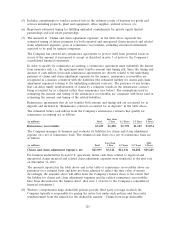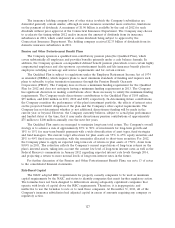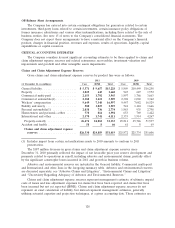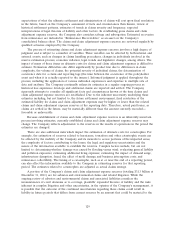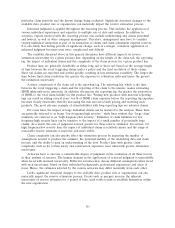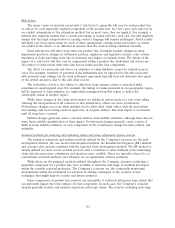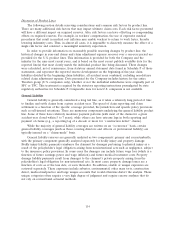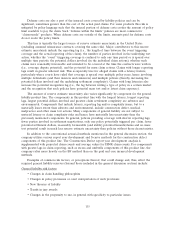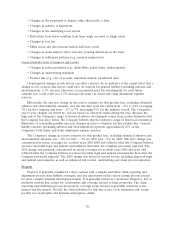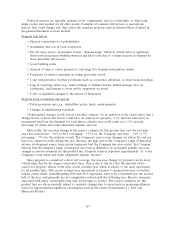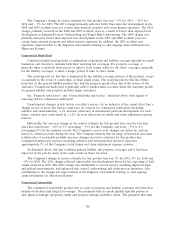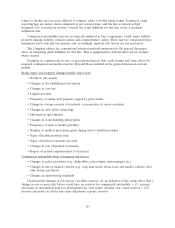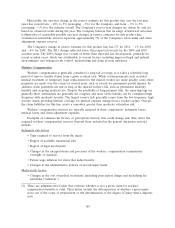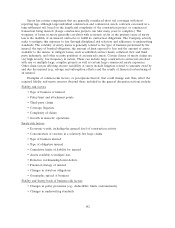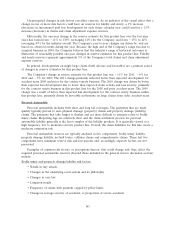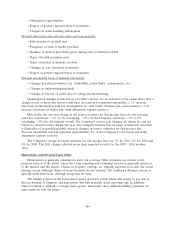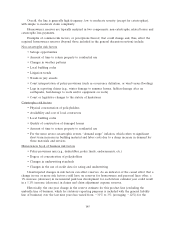Travelers 2011 Annual Report Download - page 147
Download and view the complete annual report
Please find page 147 of the 2011 Travelers annual report below. You can navigate through the pages in the report by either clicking on the pages listed below, or by using the keyword search tool below to find specific information within the annual report.
Defense costs are also a part of the insured costs covered by liability policies and can be
significant, sometimes greater than the cost of the actual paid claims. For some products this risk is
mitigated by policy language such that the insured portion of defense costs erodes the amount of policy
limit available to pay the claim. Such ‘‘defense within the limits’’ policies are most common for
‘‘claims-made’’ products. When defense costs are outside of the limits, amounts paid for defense costs
do not erode the policy limits.
This line is typically the largest source of reserve estimate uncertainty in the United States
(excluding assumed reinsurance contracts covering the same risk). Major contributors to this reserve
estimate uncertainty include the reporting lag (i.e., the length of time between the event triggering
coverage and the actual reporting of the claim), the number of parties involved in the underlying tort
action, whether the ‘‘event’’ triggering coverage is confined to only one time period or is spread over
multiple time periods, the potential dollars involved (in the individual claim actions), whether such
claims were reasonably foreseeable and intended to be covered at the time the contracts were written
(i.e., coverage dispute potential), and the potential for mass claim actions. Claims with longer reporting
lags result in greater inherent risk. This is especially true for alleged claims with a latency feature,
particularly where courts have ruled that coverage is spread over multiple policy years, hence involving
multiple defendants (and their insurers and reinsurers) and multiple policies (thereby increasing the
potential dollars involved and the underlying settlement complexity). Claims with long latencies also
increase the potential recognition lag (i.e., the lag between writing a type of policy in a certain market
and the recognition that such policies have potential mass tort and/or latent claim exposure).
The amount of reserve estimate uncertainty also varies significantly by component for the general
liability product line. The components in this product line with the longest latency, longest reporting
lags, largest potential dollars involved and greatest claim settlement complexity are asbestos and
environmental. Components that include latency, reporting lag and/or complexity issues, but to a
materially lesser extent than asbestos and environmental, include construction defect, medical
malpractice and other mass tort actions. Many components of general liability are not subject to
material latency or claim complexity risks and hence have materially less uncertainty than the
previously mentioned components. In general, policies providing coverage with shorter reporting lags,
fewer parties involved in settlement negotiations, only one policy potentially triggered per claim, fewer
potential settlement dollars, reasonably foreseeable (and stable) potential hazards/claims and no mass
tort potential result in much less reserve estimate uncertainty than policies without those characteristics.
In addition to the conventional actuarial methods mentioned in the general discussion section, the
company utilizes various report year development and S-curve methods for the construction defect
components of this product line. The Construction Defect report year development analysis is
supplemented with projected claim counts and average values for IBNR claim counts. For components
with greater lags in claim reporting, such as excess and umbrella components of this product line, the
company relies more heavily on the BF method than on the paid and case incurred development
methods.
Examples of common risk factors, or perceptions thereof, that could change and, thus, affect the
required general liability reserves (beyond those included in the general discussion section) include:
General liability risk factors
• Changes in claim handling philosophies
• Changes in policy provisions or court interpretation of such provisions
• New theories of liability
• Trends in jury awards
• Changes in the propensity to sue, in general with specificity to particular issues
135


